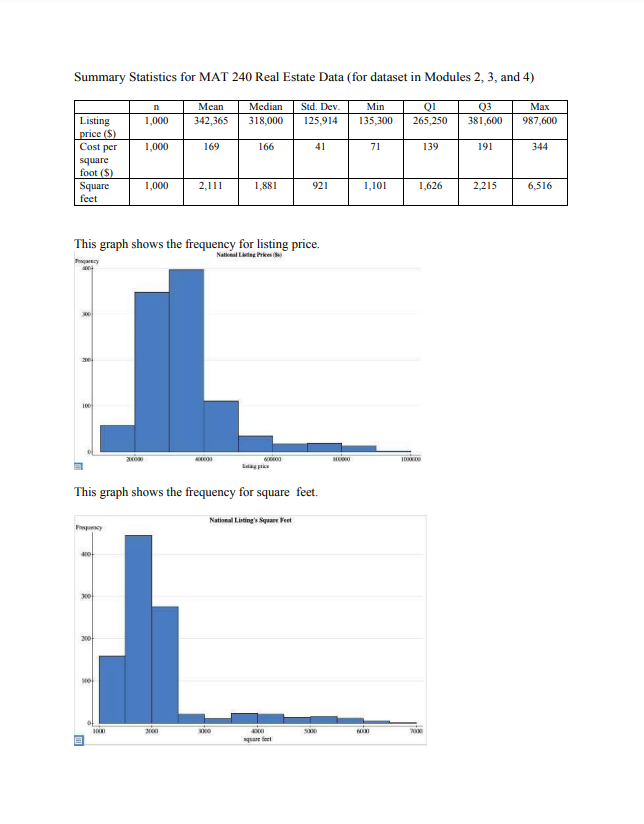Question
Overview- The purpose is to do all of the steps of a real-world linear regression research project starting with developing a research question, then making
Overview-
The purpose is to do all of the steps of a real-world linear regression research project starting with developing a research question, then making a comprehensive statistical analysis, and ending with summarizing your research conclusions.
Scenario-
You have been hired by the D. M. Pan National Real Estate Company to develop a model to predict housing prices for homes sold in 2019. The CEO of D. M. Pan wants to use this information to help their real estate agents better determine the use of square footage as a benchmark for listing prices on homes. The task is to provide a report predicting the housing prices based square footage. To complete this task, use the provided real estate data set for all U.S. home sales as well as national descriptive statistics and graphs provided.
Generate a report including your tables and graphs to determine if the square footage of a house is a good indicator for what the listing price should be. Describe the report: Give a brief description of the purpose of your report.
- Define the question your report is trying to answer.
- Explain when using linear regression is most appropriate.
- When using linear regression, what would you expect the scatterplot to look like?
- Explain the difference between predictor (x) and response (y) variables in a linear regression to justify the selection of variables.
Data Collection
- Sampling the data: Select a random sample of 50 houses. Describe how you obtained your sample data (provide Excel formulas as appropriate).
- Identify your predictor and response variables.
- Scatterplot: Make a scatterplot of your predictor and response variables to ensure they are appropriate for developing a linear model.
Data Analysis
- Histogram: Make a histogram for each of the two variables.
- Summary statistics: For your two variables, make a table to show the mean, median, and standard deviation.
- Interpret the graphs and statistics:
- Based on your graphs and sample statistics, interpret the center, spread, shape, and any unusual characteristic (outliers, gaps, etc.) for house sales and square footage.
- Compare and contrast the center, shape, spread, and any unusual characteristic for your sample of house sales with the national population (under Supporting Materials, see the National Summary Statistics and Graphs House Listing Price by Region PDF). Determine whether your sample is representative of national housing market sales.
Develop Your Regression Model
- Scatterplot: Provide a scatterplot of the variables with a line of best fit and regression equation.
- Based on your scatterplot, explain if a regression model is appropriate.
- Discuss associations: Based on the scatterplot, discuss the association (direction, strength, form) in the context of your model.
- Identify any possible outliers or influential points and discuss their effect on the correlation.
- Discuss keeping or removing outlier data points and what impact your decision would have on your model.
- Calculate r: Calculate the correlation coefficient (r).
- Explain how the r value you calculated supports what you noticed in your scatterplot.
Determine the Line of Best Fit. Clearly define your variables. Find and interpret the regression equation. Assess the strength of the model.
- Regression equation: Write the regression equation (i.e., line of best fit) and clearly define your variables.
- Interpret regression equation: Interpret the slope and intercept in context. For example, answer the questions: what does the slope represent in this situation? What does the intercept represent? Revisit the Scenario above.
- Strength of the equation: Provide and interpret R-squared.
- Determine the strength of the linear regression equation you developed.
- Use regression equation to make predictions: Use your regression equation to predict how much you should list your home for based on the assumed square footage of your home at 1500 square feet.
Conclusions
- Summarize findings: In one paragraph, summarize your findings in clear and concise plain language for the CEO to understand. Summarize your results.
- Did you see the results you expected, or was anything different from your expectations or experiences?
- What changes could support different results, or help to solve a different problem?
- Provide at least one question that would be interesting for follow-up research.

Step by Step Solution
There are 3 Steps involved in it
Step: 1

Get Instant Access to Expert-Tailored Solutions
See step-by-step solutions with expert insights and AI powered tools for academic success
Step: 2

Step: 3

Ace Your Homework with AI
Get the answers you need in no time with our AI-driven, step-by-step assistance
Get Started


